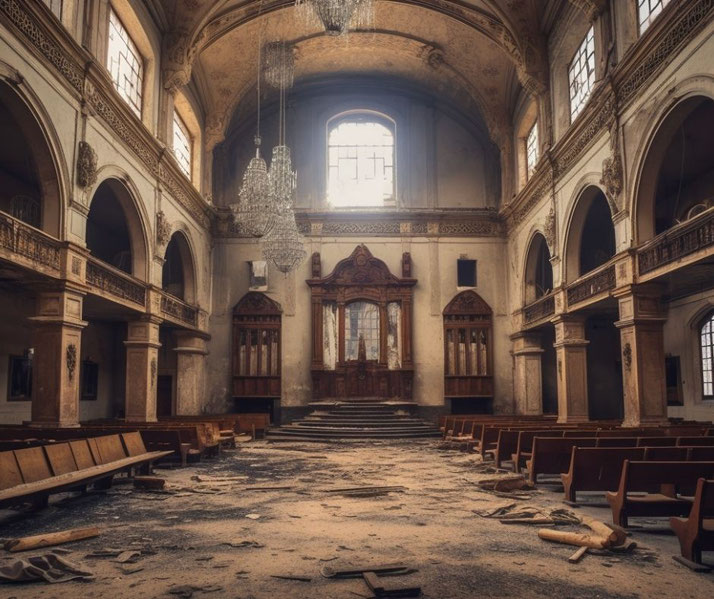From temple ruins to Zion's dream: Jewish History from AD 70 to the 19th century

The history of the Jewish people from AD 70 to the end of the 19th century saw a diaspora that spread Jewish communities far and wide, from the academies of Babylon to the bustling streets of medieval Spain and the cold expanses of Eastern Europe.
As they moved, they carried with them their traditions, beliefs, and practices, which evolved in response to their diverse environments.
Throughout the subsequent medieval period, Jews experienced both golden ages of acceptance and dark times of persecution.
The diaspora begins
The destruction of the Second Temple in AD 70 by Roman forces was a dramatic turning point for the Jewish people.
With the heart of their religious and cultural life in ruins, many Jews found themselves displaced from their ancestral homeland.
This event catalyzed the beginning of a widespread diaspora, a dispersal that would see Jewish communities establish themselves in regions far from Jerusalem.
As they ventured beyond the borders of Judea, Jewish communities began to settle in various parts of the Roman Empire, including North Africa, Asia Minor, and Europe.
Babylon, in particular, became significant for Jewish life and scholarship.
The Babylonian academies of Sura and Pumbedita became centers of Jewish scholarship after the destruction of the Temple, where scholars compiled the Babylonian Talmud between the 3rd and 5th centuries CE.
In the subsequent centuries, the diaspora expanded even further. Jewish merchants, scholars, and families traveled along trade routes, bringing with them their traditions and customs.
In the Iberian Peninsula, for instance, a vibrant Jewish community emerged, contributing to the intellectual and cultural life of both Muslim and Christian kingdoms.
Similarly, in regions like North Africa and parts of the Byzantine Empire, Jewish communities played integral roles in commerce, academia, and local governance.
The rise of Rabbinic Judaism
The destruction of the Second Temple left a profound void in the religious and cultural life of the Jewish people.
Without the central institution that had anchored their worship and rituals, there was a pressing need for a new framework to guide Jewish life and ensure the continuity of their traditions.
This vacuum led to the emergence of Rabbinic Judaism, a transformative movement that would shape the trajectory of Jewish thought and practice for centuries to come.
At the forefront of this movement were the rabbis, learned scholars and teachers who took on the mantle of interpreting and preserving Jewish law, or Halakha.
They engaged in rigorous debates, discussions, and interpretations of the Torah, seeking to understand its teachings in the context of a rapidly changing world.
Their deliberations were meticulously recorded, leading to the compilation of the Mishnah, a structured collection of oral traditions and laws.
This text, in turn, became the foundation for further commentary, resulting in the creation of the Talmud, a comprehensive and central text in Jewish scholarship.
Rabbinic Judaism wasn't just an intellectual endeavor; it had profound implications for daily Jewish life.
With the Temple gone, the rabbis emphasized the importance of personal piety, prayer, and the study of sacred texts.
Synagogues, which had previously served as community centers and places of learning, took on a more central role in religious worship.
The home became a focal point for religious observance, with rituals like the Sabbath dinner and the Passover Seder reinforcing communal bonds and traditions.
Medieval Jewish life
In the early medieval period, many Jewish communities found themselves under Islamic rule, especially after the rapid expansion of the Muslim Caliphates.
Places like Al-Andalus in Spain became centers of Jewish intellectual and cultural activity.
Here, Jewish scholars, poets, and physicians thrived, often serving as intermediaries between the Muslim and Christian worlds.
They translated works from Arabic to Latin, contributing to the preservation and transmission of ancient knowledge.
The relative tolerance of these Islamic realms allowed Jewish thought to flourish, producing luminaries such as Maimonides, whose philosophical and religious writings remain influential to this day.
Conversely, in Christian Europe, the situation was more complex. While there were periods of relative peace and coexistence, Jews often faced restrictions on their professions, were confined to specific quarters or ghettos, and were subjected to special taxes.
This was driven by the dominance of Christianity, which deeply influenced medieval thought, Jews were frequently accused of being responsible for the death of Jesus.
This theological claim, combined with persistent preaching about Jewish culpability, shaped negative perceptions among the general population.
Religious leaders often perpetuated this narrative, encouraging animosity that led to exclusionary practices and discrimination.
As a result, Jews were commonly ostracized from broader society, denied basic rights, and targeted during moments of social unrest.
As a result, Jews were often forced into occupations that Christians deemed undesirable, such as moneylending, due to restrictions on land ownership and guild membership.
Moneylending, though necessary for the functioning of medieval economies, was stigmatized due to its association with usury, which the Church condemned.
This created a paradox where Jews provided essential financial services yet were vilified for doing so.
As a consequence, they became scapegoats for economic hardships, particularly during periods of famine or inflation.
Yet, even in the face of adversity, Jewish life in medieval Europe was vibrant and resilient.
Communities established yeshivas, or religious schools, where students delved into the study of the Talmud and other sacred texts.
Jewish merchants played a crucial role in the trade networks that crisscrossed Europe, and Jewish artisans contributed to the local economies of the towns and cities in which they resided.
The Crusades and the impact on the Jewish people
The Crusades, a series of religious wars initiated by the Christian West between the 11th and 13th centuries, primarily aimed to reclaim the Holy Land from Muslim control.
While the primary conflict was between Christian and Muslim forces, Jewish communities often found themselves caught in the crossfire, facing dire consequences as a result of these military campaigns.
From the outset of the First Crusade in 1096, Jewish communities in the Rhineland and other parts of Europe became targets of violence.
Many Crusaders, fueled by religious fervor and seeing the Jews as enemies of Christianity, attacked and massacred Jewish populations in cities like Worms, Mainz, and Speyer.
These assaults were not isolated incidents; they were part of a broader pattern of anti-Jewish violence that accompanied the Crusader movements.
In many cases, Jews were faced with the grim choice of conversion, death, or suicide, with some communities choosing collective suicide over forced conversion or slaughter.
The Crusades also had economic implications for Jewish communities. Many Crusaders, in need of funds to support their expeditions, extorted money from Jews, often under the threat of violence.
Additionally, the establishment of Crusader states in the Levant disrupted trade routes and networks, affecting Jewish merchants who had been engaged in long-distance commerce.
Beyond the immediate physical and economic harm, the Crusades contributed to a shift in Christian attitudes towards Jews.
The portrayal of Jews as Christ-killers became more widespread, leading to increased marginalization and suspicion.
This sentiment was further exacerbated by theological developments within Christianity that emphasized the role of Jews in the crucifixion narrative.
The Age of Emancipation
The Age of Emancipation, spanning the late 18th to the 19th century, was a transformative period for European Jewry.
As the winds of change swept across Europe, bringing with them the ideals of the Enlightenment, notions of liberty, equality, and fraternity began to challenge the old societal hierarchies.
For Jews, who had long been marginalized and confined to the peripheries of European society, this era offered a glimmer of hope for greater integration and civil rights.
The Enlightenment's emphasis on reason and individual rights questioned the traditional justifications for restrictions on Jewish communities.
Philosophers and thinkers, both Jewish and non-Jewish, began to advocate for the removal of barriers that had kept Jews segregated for centuries.
They argued that granting Jews civil rights would lead to their cultural and social regeneration, allowing them to contribute fully to the broader society.
This wave of change first took root in France. The French Revolution, with its radical reimagining of society, led to the granting of full citizenship to Jews in 1791.
This monumental decision was not without its debates and controversies, but it set a precedent that would ripple across the continent.
In the subsequent decades, various European nations, influenced by the revolutionary spirit and the Napoleonic expansions, began to reconsider their treatment of Jewish populations.
From the German states to the vast territories of the Russian Empire, laws and edicts were passed that eased restrictions and granted varying degrees of civil rights to Jews.
The pogroms and anti-Semitic movements
The late 19th and early 20th centuries witnessed a surge in anti-Semitic sentiments and violent actions against Jewish communities, particularly in Eastern Europe.
Pogroms, organized and often brutal attacks against Jews, became a harrowing reality for many Jewish families and communities during this period.
Originating from the Russian word meaning "to wreak havoc", pogroms were characterized by looting, physical violence, rape, and murder.
While some of these attacks were spontaneous outbursts fueled by local grievances, many were orchestrated or tacitly supported by state authorities.
The reasons behind these violent episodes were multifaceted, ranging from economic tensions and competition for resources to deeply entrenched religious prejudices and state-sponsored efforts to divert attention from political or social issues.
Russia, with its significant Jewish population, was a particular hotspot for such violence.
The assassination of Tsar Alexander II in 1881, for which some wrongly blamed Jews, led to a series of pogroms across the Russian Empire.
These attacks intensified feelings of vulnerability among Jewish communities, prompting many to consider emigration as a means of escape.
The waves of Jewish migration to places like the United States during this period can be directly linked to the desire to flee from the threat of pogroms and seek a better life elsewhere.

What do you need help with?
Download ready-to-use digital learning resources
Copyright © History Skills 2014-2025.
Contact via email
With the exception of links to external sites, some historical sources and extracts from specific publications, all content on this website is copyrighted by History Skills. This content may not be copied, republished or redistributed without written permission from the website creator. Please use the Contact page to obtain relevant permission.





